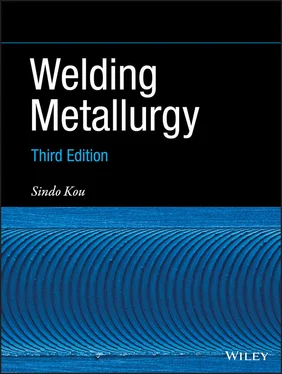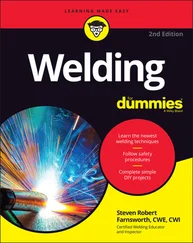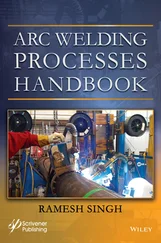
Figure 3.27Visualization of inward return flow below pool surface ( Figure 3.21b): (a) steady flow at CO 2laser power of 4 W; (b) oscillatory flow at 6 W. Two opposing inward‐flowing streams (indicated by arrows) change directions with time at a frequency of about 0.71 Hz (1 ÷ 1.4 seconds).
Source : Kou, Limmaneevitchitr and Wei [32]. Welding Journal, December 2011, © American Welding Society.
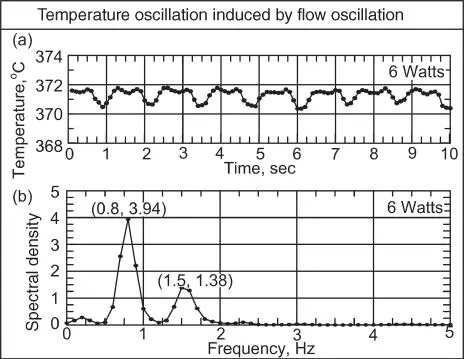
Figure 3.28Temperature measurement in NaNO 3pool during flow oscillation ( Figure 3.27b): (a) temperature oscillation detected; (b) 0.8 Hz frequency of oscillation determined by fast‐Fourier transformation, close to 0.71 Hz in Figure 3.28.
Source : Kou, Limmaneevitchitr and Wei [32]. Welding Journal, December 2011, © American Welding Society.
Kou et al. [32] showed that the surface‐active agent can affect pool‐surface deformation, pool‐surface oscillation and ripple formation – not just weld penetration as Heiple's theory shows [27]. To keep other forces, such as the Lorentz force, arc force, and recoil force, from interfering with Marangoni flow, conduction‐mode laser welding was adopted. In the conduction mode, the laser beam was defocused. 304 stainless steel (~Fe‐18Cr‐8Ni) plates (6.4 mm thick) with low (42 ppm) and high (140 ppm) sulfur contents were spot welded with a YAG laser beam defocused to 6.4 mm in diameter at the workpiece surface – similar to the diameter of a gas–tungsten arc in order to allow arc effects to be inferred in further studies. A halogen light was directed through a fiber optic bundle onto the pool surface in order to tell if the pool surface was concave (large light spot), convex (small light spot), or oscillatory (moving light spot).
The significant effect of the surface‐active agent S on the welding of 304 stainless steel is summarized in Figure 3.29. The laser power is 2800 W and the welding time 5 s. With low S (42 ppm), the large halogen light spot on the pool surface indicates the pool surface is concave. Furthermore, the fast variations in the position of the light spot with respect to the pool boundary indicates the pool surface is oscillating. Fast shaking of the pool surface was clearly visible in the videotape recoded. The resultant weld shows clear ripples and a shallow penetration. With high S (140 ppm), however, the light spot is small and steady, indicating a convex and calm pool surface (clearly shown in video). The resultant weld shows no clear ripples and a deeper penetration. This S effect on weld penetration is consistent with the theory of Heiple and Roper.

Figure 3.29Conduction‐mode laser spot welding (defocused laser beam, no keyhole) with halogen light directed at pool surface: (a) (b) (c) low S; (d) (e) (f) high S. Image of halogen light directed onto pool surface: large (concave surface) and shaking (oscillating surface) in (a) but small (convex surface) and calm (steady surface) in (d).
Source : Kou, Limmaneevitchitr, Wei [32]. Welding Journal, December 2011, © American Welding Society.
The evidence of pool‐surface oscillation during solidification is shown in Figure 3.30for the low‐S stainless steel [53]. As mentioned previously, the laser power is 2800 W and the welding time 5 s. Upon turning off the laser, oscillation of the low‐S pool surface, though weakens, still continues briefly. The multiple images of the light spot on the pool surface (e.g. Figure 3.30e) indicate pool‐surface oscillation at a frequency above 30 Hz (30 frames/s). The oscillation frequency can be estimated based on the time for the pool diameter to decrease slightly (from the videotape movie) and the number of ripples corresponding to that decrease (from the resultant weld surface). Taking a 8.5 mm‐diameter pool of low‐S stainless steel as an example, the oscillation frequency appears closer to that of mode‐2 oscillation than mode‐1, based on the equations derived by Xiao and den Ouden [54, 55] and the properties of liquid stainless steel. To identify the mode of oscillation, further investigation with a high‐speed camera may help. In contrast, after the laser was turned off, the high‐S pool showed a convex pool with a light spot significantly smaller and without multiple images [32].

Figure 3.30Oscillation of a 8.5‐mm‐diameter pool surface in conduction‐mode laser welding of 304 stainless steel with 42 ppm S: (a) before solidification; (b) through (f) during solidification, multiple light images indicating pool‐surface oscillation; (g) oscillation frequency compared with those of Mode‐1 and Mode‐2 oscillation [53, 54]. Arrowhead in (f) indicates a ripple forming at solidification front (pool edge).
Source : Kou, Limmaneevitchitr, Wei [32]. Welding Journal, December 2011, © American Welding Society.
Figure 3.31illustrates the theory Kou et al. [32] proposed for the effect of sulfur S vs. Heiple's theory [27]. With dγ / dT < 0 (42 ppm S), the surface flow is outward and the pool is shallow. The fast outward surface flow changes the otherwise convex pool surface into a concave one. The raised pool surface near the pool edge is unsupported and thus unstable, and it can oscillate along with oscillatory Marangoni flow in the pool. Surface oscillation near the pool edge can disturb solidification at the pool edge and cause clear ripple formation. With dγ / dT > 0 (140 ppm S), on the other hand, the surface flow is inward and it turns axially downward to deepen the pool as also shown by Heiple’s theory. However, the pool surface is now convex because of volume expansion upon melting. The convex pool surface is very stable because it is supported by liquid metal regardless of the effect of the inward surface flow. The stable pool is unlikely to disturb solidification at the pool edge to cause clear ripple formation.
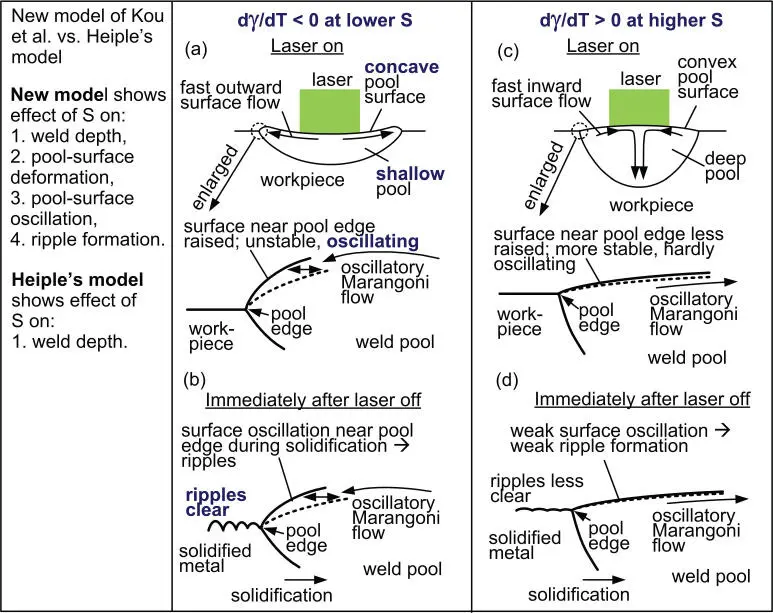
Figure 3.31New theory explaining effect of sulfur shown in Fig. 3.29: (a) (b) low S, i.e. dγ /dT < 0; (c) (d) high S, i.e., dγ /dT > 0.
Source : Kou, Limmaneevitchitr, Wei [32]. Welding Journal, December 2011, © American Welding Society.
The use of fluxes in GTAW has been found to increase weld penetration in steels and stainless steels dramatically [56–59]. The flux usually consists of oxides and halides, and it is mixed with acetone or the like to form a suspension and painted as a thin coating over the area to be welded. Figure 3.32shows transverse cross‐sections of bead‐on‐plate welds of 304 stainless steels made by GTAW without and with a commercial active flux called A‐TIG [59]. Two different 304 stainless steels were welded, one with 42 ppm S and the other 140 ppm S. In the case of low S (42 ppm), the weld penetration is clearly deeper with the active flux. In the case of high S (140 ppm S), the effect of the active flux is similar but smaller.
Читать дальше
